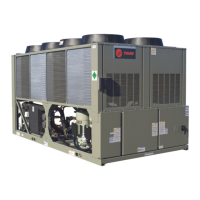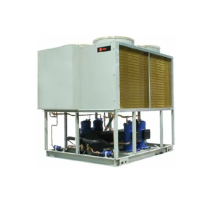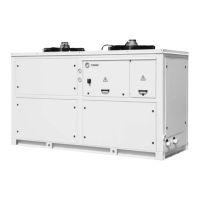156 CG-SVX17D-EN
Maintenance
• Evaporator Temperature Drop (Delta-T): 10°F
• Compressor Discharge Temperature: 63°F or more
• Compressor Suction Temperature: 20°F or more
• Condensing Pressure: 420-440 psig
• Condensing Approach Temperature: 25°F
• System Subcooling: 15-20°F
• Compressor RLA: 100 percent
If operating pressures and sight glass conditions seem to indicate a refrigerant shortage, measure
the system superheat and subcooling. Refer to “System Superheat” and “System Subcooling.”
If operating conditions indicate a refrigerant overcharge, remove refrigerant at the liquid line
service valve. Allow refrigerant to escape slowly to minimize oil loss. Use a refrigerant recovery
cylinder and do not discharge refrigerant into the atmosphere.
CAUTION
Freezing Temperatures!
Do not allow liquid refrigerant to contact skin. If it does, treat the injury similar to frostbite.
Slowly warm the affected area with lukewarm water and seek immediate medical attention.
Direct contact with liquid refrigerant could cause minor or moderate injury.
Inspect the entire system for unusual conditions and inspect the condenser coils for dirt and debris.
If the coils are dirty, refer to “Coil Cleaning” in this manual.
Monthly Maintenance
Complete all weekly maintenance procedures.
Measure and record the evaporator superheat. Refer to “Evaporator Superheat.”
Measure and record the system subcooling. Refer to “System Subcooling.”
Manually rotate the condenser fans to ensure that there is proper clearance on the fan shroud
openings.
WARNING
Rotating Components!
Disconnect all electric power, including remote disconnects before servicing. Follow proper
lockout/tagout procedures to ensure the power can not be inadvertently energized. Failure to
disconnect power before servicing could result in death or serious injury.
Annual Maintenance
Complete all weekly and monthly maintenance checks.
Check the oil level and refrigerant charge. Routine changing of oil is not required.
Have a qualified laboratory perform a compressor oil analysis to determine system moisture
content and acid level. This analysis is a valuable diagnostic tool.
Contact a qualified service provider to leak test the chiller, check operating and safety controls, and
to inspect electrical components for proper operation. Leak testing my be accomplished using soap
solution or with electronic or ultrasonic leak detectors.
Inspect all piping components for leaks and damage. Clean all water strainers.
